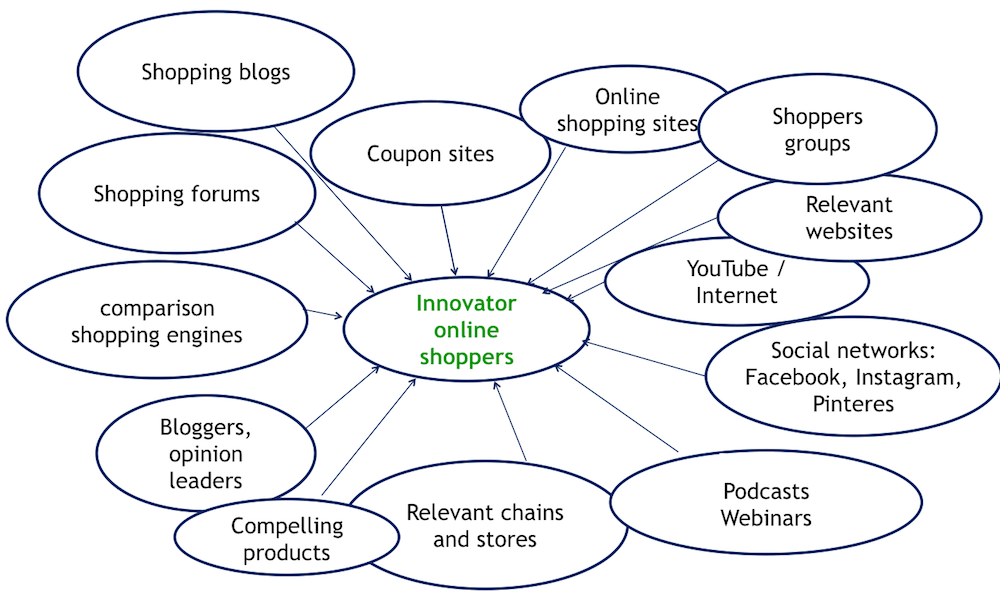As an entrepreneur, how should you choose which marketing activities to focus on?
One of the startups I loved working with was B4UPay . I believed they would succeed and trusted the two founders to do good work. And they did. But then they closed the company. Much too early. For the wrong reasons.
And I was devastated because they did everything right... Almost!
The company closed because the cost per lead and cost per customer were too high, and they realized they weren’t able to be profitable.
Finding the right marketing tools for specific audiences at different stages of the entrepreneurial company is challenging.
The marketing structure plan
I have a simple method that enables any entrepreneur to find the best tools and activities for every kind of audience, and for every stage of your company.
The reason it works is because it focuses in the only thing that matters. The customers. The money we are looking for is “in the customers’ pockets”.
Finding the target audience that will become your main and secondary customers in the coming stage of the company is based on finding the biggest opportunity in the market. I won’t get deeper into this on this post, however, I would like to point out a very important factor in the decision of which target audience you should focus on.
I’m talking about the adoption curve, which means that a new technology or product (service etc.) has different levels of adoption. In order to succeed in launching, growing, and reaching maximum customers that will use our new product, we should find out and start with innovators that are more likely to be the first to take the risk and use an unfamiliar product, followed by the early adopters, early majority, and so on.
When we think of our total market, we tend to focus on the heavy users that will need the product most and will be the most loyal customers. However, often the heavy users are not willing to take the risk of changing habits or trying an unfamiliar product until they’ve seen proof of its usefulness.
Read here to learn more about the right customers at any stage of the company and product life and using the adoption curve:
"Is there a chance you are missing your best customers?"
Targets. Goals. Objectives.
Once we figured out which target audience we should focus on at the current stage of the company and journey; it’s time, if you haven’t done it yet, to decide what objectives would we like to achieve.
In order to choose the best tools and activities for the current stage of your business, we must understand what we want to accomplish.
Finding the company’s biggest market opportunity and understanding who the target audience should be are the first steps in choosing the best marketing channels for you and your company.
The second step is to have a clear vision of what would you like to achieve. Is it the first sales? Which often start with the goal of visitors, leads, and sales. Or it could be subscribers to your site or app, downloading the free trial, etc.
The important thing is to decide on goals that will keep your business on the right track.
Putting it all together
Now we are talking about doing what this whole post is about, which is choosing the best marketing tools and activities to achieve your goals.
- - We know what product or service we have
- - Who the target audience is
- - What we want to achieve
I love to address the issue with two questions:
Where are our target audience/ potential customers?
How will we get there?
In other words, what do we do to find the target audience, capture their attention, and achieve our business goals?
In order to practice it together, let’s go back to B4UPay, the startup company I started my story with.
It was a new service aiming to bridge the gap between comparison shopping engines and sites to the actual purchases. The platform enabled the shopper to present the cheapest price found on the comparison engine and allowed retailers to offer their price; a unique take on the reverse auction.
Let’s choose innovators that buy online as our target audience.
I love to draw a little diagram and insert all the relevant places the target audience tends to congregate regarding the relevant market or need.
Where are the innovators online shoppers?

Next, based on our goals on one hand, and on our abilities and budget on the other hand, we will choose which marketing activities to focus on.
While planning our marketing activities, I love to remind entrepreneurs in my lectures that, at any given moment, you have 1 dollar and 1 minute.
Which means, according to the target audience and other relevant elements, you should ask yourself what would serve you best. What will be the next thing to put 1 dollar and 1 minute. That will be the base of the plan.
Why is it so important?
Back to the company I started this post with, since everyone talked with them about lead generation and advertising, those were the main marketing activities they focused on to launch their product. However, since it takes time for consumers to learn to trust in a new product, they had to invest a lot of money in each client.
Once they made the calculation they realized they weren’t able to be profitable and closed the company after less than six months. In the case of B4UPay, the difference between paid advertising to the other free communication channels they could use is very clear.
But it’s not only about ads versus free social media. I know of companies that invested most of their budgets on trade shows, but their customers weren’t there. I worked with a startup company on the west coast, that paid more then ten thousand dollars each month to a traditional PR agency while most of their customers didn’t read the traditional media and certainly didn’t trust their recommendations.
And the list goes on.
Using the method described here will allow you to maximize the chances of success through focusing on the right customers with a set of tools focused on the needs and goals of your business.




